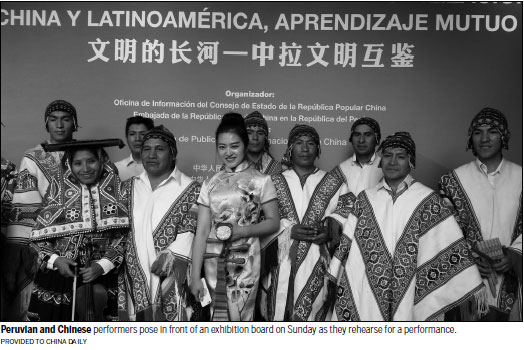Exhibit links two civilizations
By May Zhou in Lima, Peru (China Daily USA) Updated: 2016-11-22 12:04The histories of Chinese and Latin American civilizations follow an unusually similar timeline.
Chinese civilization began to flourish more than 5,000 years ago, while three ancient Latin American civilizations - the Aztec, the Inca and the Maya - were prominent around the same time.
Those Latin American cultures have a strong presence in Mexico, Chile and Peru, which are members of the Asia-Pacific Economic Cooperation.
This topic and others are covered under The Long River of Civilizations: Mutual Learning Between the Civilizations of China and Latin America, an exhibit that was inaugurated at the National Museum of Archeology, Anthropology and History of Peru, on Monday in Lima.
The exhibition, which highlights the notable development of both China and the Latin America region from BC 8,000 to AD 1800s, was a product of three years' work by Professor Wang Qijun of China's Central Academy of Fine Arts, as well as by more than 20 researchers and experts from the Latin American Institute of the Chinese Academy of Social Sciences and different Latin American countries.
It's part of a series of programs for the China-Latin America and the Caribbean Cultural Exchange Year 2016 and the APEC Economic Leaders' Meeting.
According to Yu Jiutao, publisher of China Pictorial and the project organizer, Wang's inspiration came from a speech given by President Xi Jinping at UNESCO a few years ago when he said: "Civilizations will be more colorful and rich through mutual exchange and learning."
Xi's appreciation of the development of human civilization became an inspiration for Wang, who began to work on his project with a team of scholars and experts.
"So Wang and his team developed this time chart covering almost 10,000 years of civilization history in China as well as in Latin America," said Yu. "For the same period, notable development was marked for both China and Latin America.
"It's done in a column-by-column comparison format that for both Chinese and Latin Americans, what's happening in one's homeland and in the other land was instantly clear," Yu said. "This is a very direct and visual way to achieve what Xi said about mutual exchange and learning."
The exhibition takes the form of a majestic long roll of traditional Chinese painting. It extends chronologically vertically - the upper part corresponding to China and the lower part to Latin America - and shows the great historical events of the two civilizations, as well as artistic objects, photographs, images and information.
For example, the Great Wall was completed roughly in the 1300s, while Machu Picchu was completed in the 1400s. Visually, the top-and-bottom comparisons let viewers instantly grasp what's important in both civilizations in approximately the same historical period, Yu said.
"The exhibition shows the evolution of both civilizations, which will lay a solid foundation for increasing understanding of history and culture between one another and deepening the cultural exchange. It's a great way to achieve mutual learning."
In total, the 50 meter-long roll showcases 360 vestiges and cultural relics by national category, 13 of which are located in Peru. Yu said much architecture, landscapes and valuable objects of Chinese civilization were hand drawings by the renowned professor Wang Qi of the Central Academy of Fine Arts.
"These works reflect the charm of Chinese civilization and, above all, overcome the limitations of a photograph when describing the details and reproduce the interior structure of ancient buildings and constructions," Yu said.
"We are convinced that these beautiful drawings will be a new experience for visitors."
mayzhou@chinadailyusa.com

- 'Cooperation is complementary'
- Worldwide manhunt nets 50th fugitive
- China-Japan meet seeks cooperation
- Agency ensuring natural gas supply
- Global manhunt sees China catch its 50th fugitive
- Call for 'Red Boat Spirit' a noble goal, official says
- China 'open to world' of foreign talent
- Free trade studies agreed on as Li meets with Canadian PM Trudeau
- Emojis on austerity rules from top anti-graft authority go viral
- Xi: All aboard internet express











